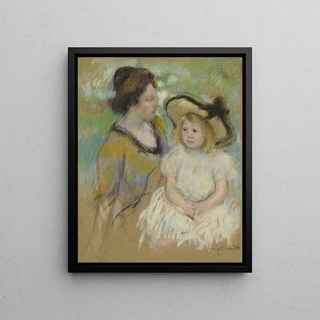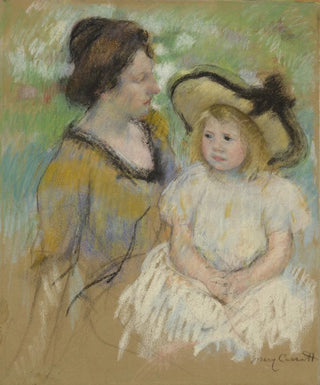Art print | Simone sitting on the grass next to her mother - Mary Cassatt


View from behind

Frame (optional)
In the fascinating world of Impressionist painting, Mary Cassatt's work stands out for its delicacy and ability to capture the intimacy of human relationships. "Simone sitting on the grass beside her mother" is a striking example of this approach, where the apparent simplicity of the scene conceals a profound emotional depth. The depiction of Simone, surrounded by greenery, evokes an atmosphere of serenity and tenderness. This artwork invites us to immerse ourselves in a moment of everyday life, where nature and family bonds intersect, revealing the beauty of shared moments.
Style and uniqueness of the work
Mary Cassatt, as a female artist in a male-dominated environment, developed a style that is uniquely her own, blending elements of the Impressionist movement with a distinctive sensitivity. In "Simone sitting on the grass beside her mother," the palette of soft colors and fluid brushstrokes create a peaceful atmosphere. The verdant hues of the garden contrast with the gentle dresses of the characters, highlighting the tenderness of the scene. Cassatt excels in depicting female figures, capturing not only their appearance but also their essence. Simone's posture, slightly turned toward her mother, reflects a relationship of trust and affection, while the mother's gentle and attentive gaze reinforces this bond. This artwork does not merely depict a mother and her daughter; it immortalizes a moment of shared complicity and joy.
The artist and her influence
Mary Cassatt, born in 1844 in Pennsylvania, was a major figure of the Impressionist movement, distinguished by her focus on subjects centered around the lives of women and children. Her collaboration with artists such as Edgar Degas enriched her artistic approach, allowing her to explore new techniques and perspectives. Cassatt also played a key role in promoting Impressionist art in the United States, contributing to the acceptance of this innovative movement. Her works, often imbued with tenderness and femininity, have inspired many artists across decades, opening

Matte finish

View from behind

Frame (optional)
In the fascinating world of Impressionist painting, Mary Cassatt's work stands out for its delicacy and ability to capture the intimacy of human relationships. "Simone sitting on the grass beside her mother" is a striking example of this approach, where the apparent simplicity of the scene conceals a profound emotional depth. The depiction of Simone, surrounded by greenery, evokes an atmosphere of serenity and tenderness. This artwork invites us to immerse ourselves in a moment of everyday life, where nature and family bonds intersect, revealing the beauty of shared moments.
Style and uniqueness of the work
Mary Cassatt, as a female artist in a male-dominated environment, developed a style that is uniquely her own, blending elements of the Impressionist movement with a distinctive sensitivity. In "Simone sitting on the grass beside her mother," the palette of soft colors and fluid brushstrokes create a peaceful atmosphere. The verdant hues of the garden contrast with the gentle dresses of the characters, highlighting the tenderness of the scene. Cassatt excels in depicting female figures, capturing not only their appearance but also their essence. Simone's posture, slightly turned toward her mother, reflects a relationship of trust and affection, while the mother's gentle and attentive gaze reinforces this bond. This artwork does not merely depict a mother and her daughter; it immortalizes a moment of shared complicity and joy.
The artist and her influence
Mary Cassatt, born in 1844 in Pennsylvania, was a major figure of the Impressionist movement, distinguished by her focus on subjects centered around the lives of women and children. Her collaboration with artists such as Edgar Degas enriched her artistic approach, allowing her to explore new techniques and perspectives. Cassatt also played a key role in promoting Impressionist art in the United States, contributing to the acceptance of this innovative movement. Her works, often imbued with tenderness and femininity, have inspired many artists across decades, opening






